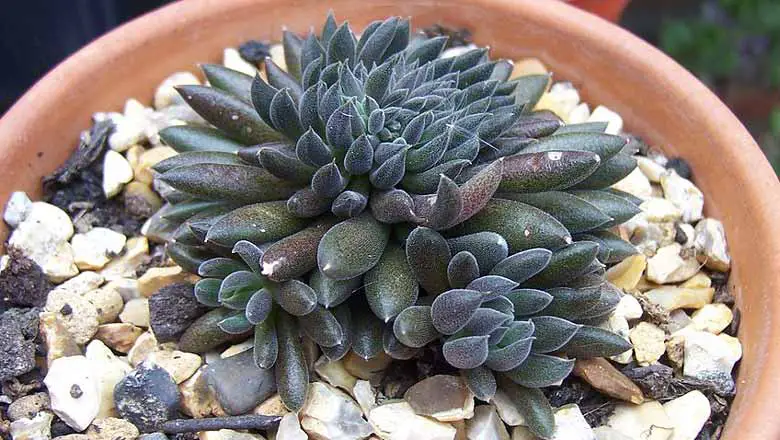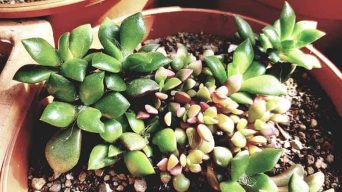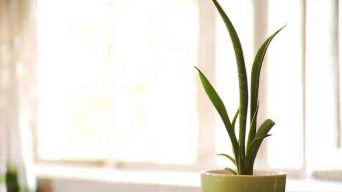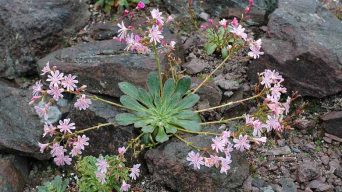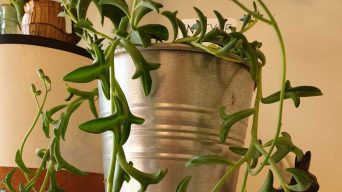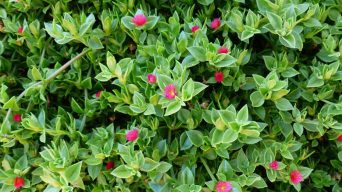The Sinocrassula Yunnanensis ‘Chinese Jade’ is a beautiful succulent plant that is native to China.
It has been cultivated in gardens worldwide, but many people don’t know how to take care of this exotic plant.
This guide will teach you everything you need to know about caring for your Sinocrassula yunnanensis and propagating it successfully!
About the Sinocrassula Yunnanensis (Chinese Jade)
The Sinocrassula Yunnanensis is a type of succulent that’s native to China and Taiwan. Also known as Chinese Jade, it was first found in Yunnan Province, so the name Sinocrassula Yunnanensis comes from.
The Sinocrassula Yunnanensis is a beautiful rosette forming succulent with multiple leaves which grow from the same point. It can be identified by its furry, hairy, and thick skin that’s greenish-gray in color.
It can grow up to about three feet in height which develops into dense clumps, but it grows much faster if you propagate the plant.
The Sinocrassula Yunnanensis is one of the most popular succulents you’ll find due to its interesting look, ease-of-care qualities, and climate adaptability.
How To Care for Sinocrassula Yunnanensis (Chinese Jade)
Sun Exposure & Light Requirements
The Sinocrassula yunnanensis prefers bright indirect light. Direct sunlight is required for flowering and the production of red leaves.
However, too much exposure may cause leaf scorch on this plant if not acclimated properly. So keep that in mind as you’re setting up your garden!
Keep out any harsh or hot midday sun during the summer months by positioning under large trees or other plants that provide some protection.
The plant prefers a location with light shade or diffused sunlight. Keep in mind it may not survive if exposed to harsh, direct sun all day during the summer months.
Sinocrassula yunnanensis does best when grown outdoors where the air and soil are warm year-round.
They will grow well indoors as long as they have plenty of bright indirect light supplemented by fluorescent lights for about four hours each day.
Watering
Watering your Sinocrassula Yunnanensis is not tricky. It would be best if you watered it as needed but do so sparingly.
The best way to know how much the plant needs watering is by placing one hand on top of the soil and ignoring any droplets that form on your fingers.
If you feel moisture, don’t water the plant until it feels dry again. If there are no droplets present, wait a few more days before checking for moistness to prevent over-watering.
After some time, you will naturally sense when your plants need watering via touch alone (remember: check with both hands).
This can take anywhere from two months to three years, depending on how often you care for your plants and how well they are adapted to their environment.
Do not water your plant if the soil is wet or muddy because of rain. Watering it will only send additional moisture into its roots and increase the risk of root rot.
Make sure you check for signs such as wilting leaves before giving your plant a drink, indicating that it needs much more water than usual.
Soil
The soil for the Sinocrassula Yunnanensis should be well-draining, rich in minerals, and soft. It is also recommended that you add a layer of gravel at the bottom to prevent over-saturation from water drainage.
The use of an organic potting mix with perlite or sand will help promote good drainage and allow more air circulation within your medium.
A soil mixture of one part good organic potting mix, two parts sand, and three parts perlite is a suitable alternative.
Do not use soft or acidic soils, which may inhibit root development.
The best soils promote the formation of taproots and have high water retention capacity but do not stay wet for extended periods as this will lead to bacterial and fungal rot problems.
Be sure to choose your soil with these factors in mind before planting.
Temperature and Humidity
The preferred temperature range for the Sinocrassula Yunnanensis is 60°F-80°F during the day and 40°F-65°F at night.
A 50% to 80% humidity level is ideal with “purple bell” type leaves. However, it can tolerate a wide variety of climates so long as they have sufficient light.
Sinocrassula yunnanensis is tolerant to cold temperatures. But when exposed to cool nights for too long, it may die back, or the leaves will wilt and droop from lack of moisture in the air.
This succulent prefers humid environments that range between 50% – 80% humidity levels, which means that you should mist the plant often and provide it with a humidity tray.
The best way to do this is by using pebbles or gravel in a shallow dish that will hold about an inch of water, so when you mist the plants, droplets can travel through the air around them.
Fertilizing Sinocrassula Yunnanensis
Fertilizing a Sinocrassula yunnanensis is unnecessary if it’s planted in soil with the nutrients it needs.
However, fertilization can be helpful for those who grow their plants outside or have used a poor-quality potting mix to plant them.
If you plan on using fertilizer, try to use organic liquid food with an NPK of equal parts nitrogen, phosphorous, and potassium. This will help both young and mature plants thrive.
When applying fertilizer, do so lightly around the edges of the pot because an intense application may burn your roots.
Potting and Repotting
The container in which you plant your Sinocrassula is very important.
You want to use a pot with good drainage, roomy enough for root growth and deep enough so that the soil level will not be above the crown of leaves when it grows taller.
Clay pots are often recommended as they dry out more slowly than plastic ones do, but choose what’s best for you.
A classic rule of thumb: go up by two sizes larger each time before repotting, e.g., from a four-inch pot to an eight-inch pot or from six inches to twelve inches. This allows plenty of space for roots to grow without being cramped.
You should only repot your plant when it is necessary or if the current pot has been overwatered.
Giving your plants some space is essential, so you’ll want to wait until root growths come up from the drainage holes. If you see that, then it’s time for a larger pot.
If you’re planting in an eight-inch diameter container, fill it halfway with soil and tap down firmly but carefully; don’t overpack!
Now add more soil gradually to the top of the dirt. Do this until it is four inches deep.
Make sure that you fill any spaces around the roots and cover them with soil. Then put soil on top so that it’s all covered. You can use a spoonful of perlite or potting soil to help retain moisture.
Don’t overwater your plant! This can lead to root rot, so it’s essential that the drainage holes in the pot are open and not clogged with dirt.
You should put more pebbles at the bottom of your pot if it is larger than 8 inches in diameter. This is important because the clay will absorb water much faster than plastic pots would.
Pruning
Pruning is a process that removes dead, dying, or damaged tissue from the plant. It can also be used to reduce the size of leggy plants and promote branching in certain species.
Over-pruning will damage new growth, so it should not be done unless necessary. Pruning is a good thing to do when the weather is good. It will help heal the tree.
You might want to wait until after it rains. If it does not rain for a long time, you should wait until the sun shines on your plant and then do the pruning.
The best time to do this kind of operation is during the growing season (March – October), but one can prune off any old leaf stem no matter what month it is.
When trimming succulents like Sinocrassula yunnanensis, do not pull out too much. This can damage new growth and encourage the plant to grow toward the light.
Pests and Diseases
The Sinocrassula Yunnanensis succulent plants are susceptible to pests and diseases.
Diseases
The Sinocrassula Yunnanensis succulent plant is prone to root rot and fungal infections.
These are often caused by overwatering the soil or planting in an area with poor drainage, which will cause waterlogging that can lead to root rot.
If the plants show wilting signs, they could be suffering from too much sun exposure, so find a shady spot for them if possible.
Make sure you’re not overwatering your succulents. Check regularly on their soil’s moisture – poke around with your finger!
The top few inches should feel dry before adding any water. Be careful not to let the pot completely dry out either, as this will kill the plant.
Pests
Sinocrassula Yunnanensis are susceptible to mites, scale, mealybugs, and aphids.
These pests suck the sap out of plants or introduce dangerous pathogens into them so they cannot get enough water or nutrients from the soil alone.
- Mites are tiny, barely visible to the naked eye, and release a substance that will cause leaves to turn yellow. They can be challenging to control if you don’t notice their presence early on. They usually come in many numbers, so take care when handling or moving any Sinocrassula yunnanensis plants.
- Scale insects are small and hard to see. They hide in tiny places where we cannot reach them with our fingers. These pests have protective outer shells. If left unchecked, then scale could completely cover your plant’s stem or branch, which will soon lead it to death by dehydration!
- Mealybugs are also easy enough to spot; white cottony masses usually hide inside leaves or in the leaf axils.
- Aphids are the most manageable pest to eliminate because they are so small. They usually congregate on the tips of leaves, and if you knock off a few, more will come in their place until there’s a total infestation.
The best ways to control any pests without hurting your plant are:
- Warm, soapy water makes an excellent cleaning agent! Just spray this all over until you see dirt wash off of the surface, then rinse well with clean water afterward.
- You can use neem oil or other insecticidal soap sprays to kill pests. But remember not to apply these sprays directly under the sun because it will damage your Sinocrassula plants.
- A fine mist of water and insecticidal soap spray will work well without the need for rinsing afterward.
- One last option is to use a cotton swab dipped in alcohol. This is not good for plants because it can dry out their tissues and cause brown spots on the leaves.
How To Propagate Sinocrassula Yunnanensis (Chinese Jade)
Sinocrassula Yunnanensis plants are propagated by stem cuttings.
Choose a healthy, non-flowering shoot and remove the leaves from it using sharp scissors or clippers. This is called ‘pinching back’.
The removed leaves will encourage new growth to push out of this area. Cut off the lower tip at an angle (to reduce water loss).
Stick the cutting into well-draining soil with a little potting mix on top. If you don’t have any potting mix, use a small pebble. But make sure there is space between the stones for air to get in so the roots can breathe.
After you plant your Sinocrassula and water it, wait patiently for it to grow.
If your plant is flowering, making a new stem and growing the plant would be hard. The stem has fewer roots. And you might lose the plant again.
The best time to propagate Sinocrassula Yunnanensis by cutting is in early spring and late summer when there’s a lot of growth but no flowers.
It would help if you pinched the shoots back before they bloom for the best results.
Is the Sinocrassula Yunnanensis (Chinese Jade) Toxic?
The Sinocrassula Yunnanensis is not a toxic plant! Though, some people have reported mild irritation from touching this succulent.
There may also be an allergic reaction to the oils found in the leaves and stems of plants with a similar genus as Sinocrassulaceae.
This succulent does have a sap that can cause some minor irritation for the skin and eyes if touched directly. It’s best to avoid contact with these surfaces.
A diluted solution of hydrogen peroxide may help clean off any oils left behind on your hands or other body parts and protect against further irritations from this plant.
It should be noted that Sinocrassula Yunnanensis plants are not toxic but might cause irritation when touching them.
This is because of the oil residue. Washing your hands after handling them would be wise so you don’t get it anywhere else (like in your mouth or eyes).
Final Thoughts
The Sinocrassula Yunnanensis is a beautiful succulent that can be grown in container gardens and as a houseplant.
It requires little care; it will need water during winter, but not too often or heavily. Remember to repot your plant every few years so it doesn’t become rootbound.
If you’re patient with watering, this plant may bloom for the first time about two years after you start caring for it!

